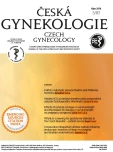The effect of myomectomy on the morphology uterine and tubal factor of infertility
Authors:
E. Filipinská; R. Hudeček; L. Mekiňová; M. Dziakova; P. Ventruba
Authors‘ workplace:
Gynekologicko-porodnická klinika LF MU a FN, Brno, přednosta prof. MUDr. P. Ventruba, DrSc., MBA
Published in:
Ceska Gynekol 2018; 83(6): 412-417
Category:
Overview
Objective:
To compare the incidence of uterine cavity distortion and tubal factor before and after myomectomy in women with symptomatic uterine fibroids, which are planning pregnancy.
Study design:
Prospective, unicentric, cohort study.
Setting:
Department of Gynecology and Obstetrics Masaryk University and University Hospital Brno.
Methods:
The tracked file consists of 108 patients with intramural or subserous myoma or myomas, which underwent laparoscopic (LM, n = 60, 55.6%) or open (OM, n = 48, 44.4%) myomectomy in the period from 2013 to 2016 at the Department of Gynecology and Obstetrics LF MU and FN Brno. The analysis is focused on the comparison of incidence of uterine cavity distortion and tubal factor using sonohysterosalpingography (sono HSG) or combination of laparoscopy with chromopertubation and ultrasound before and after surgical intervention.
Results:
The incidence of uterine cavity distortion in patients after myomectomy was significantly lower compared to the original file in patients before myomectomy, and it in both branches of the study (LM and OM), (n1 = 37, n2 = 0, p < 0,001). The incidence of tubal factor in patients after myomectomy was insignificantly lower compared to patients before myomectomy, and it in both branches of study, (LM i OM), (n1 = 29, n2 = 20, p = 0.239).
Conclusion:
Myomectomy in patients with intramural or subserous myoma or myomas significantly decreases the incidence of uterine cavity distortion and unsignificantly decreases tubal factor without dependence on used laparoscopic or open method.
Keywords
myoma, myomectomy, uterine factor, tubal factor
Sources
1. Briceag, I., Cosache, A., Purcarea, VL., et al. Fallopian tubes-literature review of anatomy and etiology in female infertility. J Med Life, 2015, 8, p. 129–131.
2. Donnez, J., Dolmans, MM. Uterine fibroid management: from the present to the future. Hum Reprod, 2016, p. 1–22.
3. Donnez, J., Hudecek, R., Donnez, O., et al. Efficacy and safety of repeated use of ulipristal acetate in uterine fibroids. Fertil Steril, 2015, 103, p. 519–527.
4. Donnez, J., Jadoul, P. What are the implications of myomas on fertility? Hum Reprod, 2002, 17, p. 1424–1430.
5. Guven, S., Kart, C., Unsal, MA., et al. Intramural leiomyoma without endometrial cavity distortion may negatively affect the ICSI-ET outcome. Rep Biol and Endoc, 2013, 11, p. 102–109.
6. Hackethal, A., Westermann, A., Tchartchian, T., et al. Laparoscopic myomectomy in patients with uterine myomas associated with infertility. Min Invasiv Ther, 2011, 20, p. 338–345.
7. Hermann, A., De Wilde, RL. Laparoscopic myomectomy – the gold standard. Gynecol Min Invasiv Ther, 2014, 32, p. 31–38.
8. Krajčovičová, R., Hudeček, R. Vliv děložní myomatózy na reprodukční funkce. Prakt gyn, 2010, 4, s. 154–163.
9. Kumakiri, J., Kikichi, I., Kitade, M., et al. Association between uterine repair at laparoscopic myomectomy and postoperative adhesions. Acta Obstet Gynecol Scan, 2012, 91, p. 331–337.
10. Kumakiri, J., Kikuchi, I., Kitade, M., et al. Evaluation of factors contributing to uterine scar formation after laparoscopic myomectomy. Acta Obstet Gynecol, 2010, 89, p. 1078–1083.
11. Lev-Toaff, AS., Karasick, S., Toaff, ME. Hysterosalpingography before and after myomectomy: clinical value and imaging findings. Amer J Radiol, 1992, 160, p. 803–807.
12. Mara, M., Kubinova, K., Makova, J., et al. Uterine artery embolisation versus laparoscopic uterine artery occlusion: the outcomes of a propesctive , nonrandomized clinical trial. Cardiovasc Intervent Radiol, 2012, 5, p. 1041–1052.
13. Mattei, A., Cioni, R., Bargelli, G., et al. Techniques of laparoscopic myomectomy. Reprod Biomed Online, 2011, 23, p. 34–39.
14. Mekiňová, L., Janků, P., Filipinská, E., et al. Incidence císařského řezu a úspěšnost vaginálně vedeného porodu u těhotných po myomektomii. Čes Gynek, 2016, 81, s. 404–409.
15. Metwally, M., Cheong, YC., Horne, AW. Surgical treatment of fibroids for subfertility (Review). Cochrane Database of Systematic Reviews, 2012, 11.
16. Palomba, S., Fornaciari, E., Falbo, A., et al. Safety and efficacy of the minilaparotomy for myomectomy: a systematic review and meta-analysis of randomized and non-randomized controlled trials. Reprod Biomed Online, 2015, 30, p. 462–481.
17. Panchal, S., Nagori, C. Imaging techniques for assessement of tubal status. J Hum Reprod Sci, 2014, 7, p. 1–12.
18. Purohit, P., Vigneswaran, K. Fibroids and infertility. Curr Obstet Gynecol Rep, 2016, 5, p. 81–88.
19. Tinelli, A., Hurst, BS., Hudelist, G., et al. Laparoscopic myomectomy focusing in the myoma pseudocapsule: technical and outcome report. Hum Reprod, 2012, 27, p. 427–435.
20. Tinelli, A., Malvasi, A., Hurst, BS., et al. Surgical management of neurovascular bundle in uterine fibroid pseudocapsule.J Soc Laparoend, 16, p. 119–129.
21. Zeipiridis, L., Grimbiris, GF., et al. Infertility and uterinefibroids. Best Pract Res Clin Obstet Gynaecol, 2016, 34, p. 66–73
Labels
Paediatric gynaecology Gynaecology and obstetrics Reproduction medicineArticle was published in
Czech Gynaecology

2018 Issue 6
Most read in this issue
- Etiology, risk factors, and methods of postpartum depression prevention
- Radiofrequency endometrial ablation – new possibility of heavy menstrual bleeding conservative treatment
- Asherman‘s syndrome: the description of two case reports
- Perinatal mortality and morbidity in Slovak Republic in the years 2007–2015
